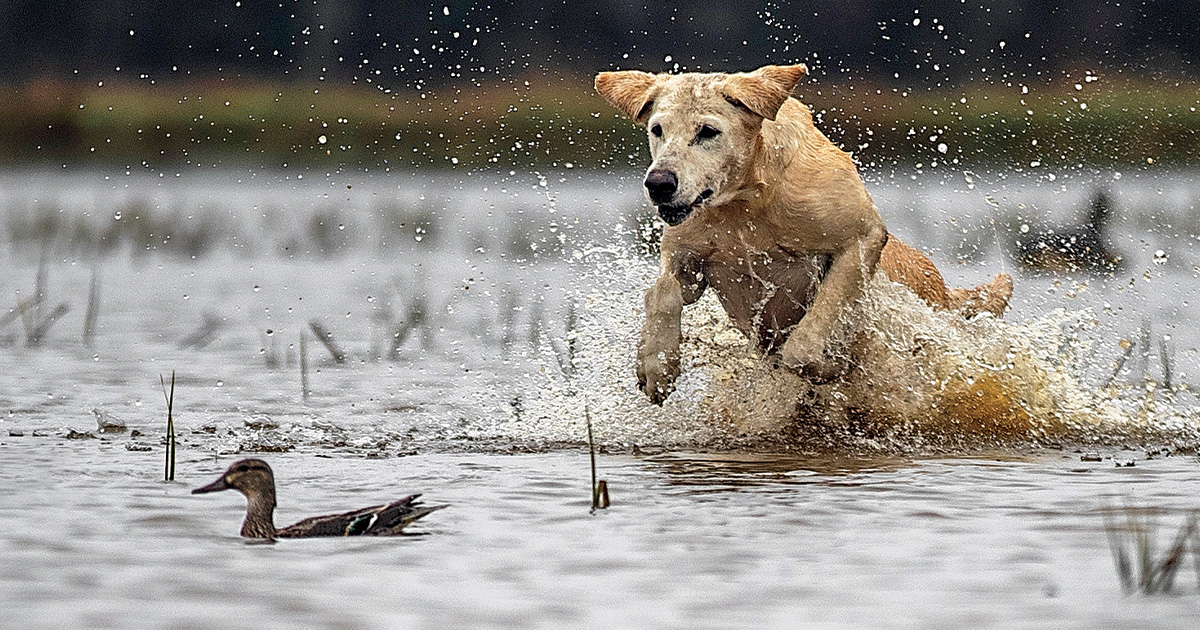Retrievers: The Chase
Finding and retrieving crippled birds is a duck dog's most valuable skill
Finding and retrieving crippled birds is a duck dog's most valuable skill


With proper training and experience, a retriever can recover birds that might otherwise have been lost.
The revered outdoor writer Nash Buckingham famously observed that “The best long-range shotgun load to have in one’s boat for mallards is a fine retriever.” Implicit in that statement is the fact that not every duck hit by shotgun fire falls dead, and some of these birds elude our best efforts to capture them. There are things that all of us can do as conservation-minded sportsmen to ensure that we lose as few birds as possible, but the single biggest step we can take is to heed Buckingham’s advice and employ the services of a well-trained retriever.
It’s important to use a careful, well-thought-out approach to training your retriever to handle cripples. “If the first time a dog encounters a live bird is in a hunting situation, and that bird flaps its wings in his face, you’re asking for trouble if the dog is at all timid,” says Lonny Taylor, a veteran trainer and the proprietor of Taylor Made Retrievers in Mount Hope, Kansas. “The absolute worst mistake you can make is to take a young, inexperienced dog on a field hunt for Canada geese. Sending a novice retriever after a big honker that’s lightly hit is a recipe for creating a bird-shy dog.”
The key to training for crippled birds, Taylor says, is to expose the dog to “shackled” birds—birds whose wings are tied together near the body. Taylor prefers using a couple of wraps of plastic surveyor’s tape. Because they’re lively and retain some mobility, shackled birds simulate the behavior of crippled birds. The idea, he explains, is to produce a bird that “can’t fly off when you throw it but can use its wings to break its fall.” Most professional trainers will happily sell you a few birds at the going rate (expect to pay around five dollars for a pigeon and somewhere north of 20 dollars for a mallard).
Taylor transitions to shackled birds only after the dog has received a solid introduction to birds and is retrieving dead ones reliably. He begins the shackled-bird training with pigeons, and he takes pains to try to duplicate the conditions the dog is likely to hunt in.
Once the dog is confidently retrieving shackled pigeons, Taylor ramps up to shackled ducks. Not only are ducks sneakier and more elusive than pigeons, they also provide a little “push-back,” quacking, flapping, and even pecking, all of which the dog needs to learn to deal with. Taylor cautions, though, that if a duck “gets wise” and starts pecking very aggressively, you may have to tape its bill shut, taking care not to cover the nostrils, obviously.
Also, because shackled ducks generally behave the same way on the water that cripples do—diving, surfacing, and resurfacing again—they’re terrific for teaching dogs how to handle this most challenging of real-world retrieving tasks. The caveat, Taylor says, is that you should be sure to have a seasoned dog waiting in the wings when you run this drill, just in case the youngster finds himself overmatched.
This raises the important point that while you can lay a foundation with training, at some point you have to step aside, let instinct take over, and allow the dog to learn from experience. Taylor cites the example of a crippled duck that disappears into the weeds: “The best thing you can do in this scenario,” he says, “is swallow your whistle and let your dog hunt. You have to learn to trust your dog, and in particular to trust his nose. There’s nothing you can do to improve his chances of coming up with that bird. Just let him go.”
On the other hand, there are times when stepping in is exactly the right thing to do. Simply stated, no bird is worth putting your dog at risk. If you sense your dog tiring while trying to corral a cripple, pull the plug and call him in. Ditto if you suspect that he may be lapsing into hypothermia, showing signs of heat stress, or putting himself in harm’s way in the form of ice, current, waves, or obstructions in the water.
Ducks Unlimited uses cookies to enhance your browsing experience, optimize site functionality, analyze traffic, and deliver personalized advertising through third parties. By continuing to use this site, you agree to our use of cookies. View Privacy Policy